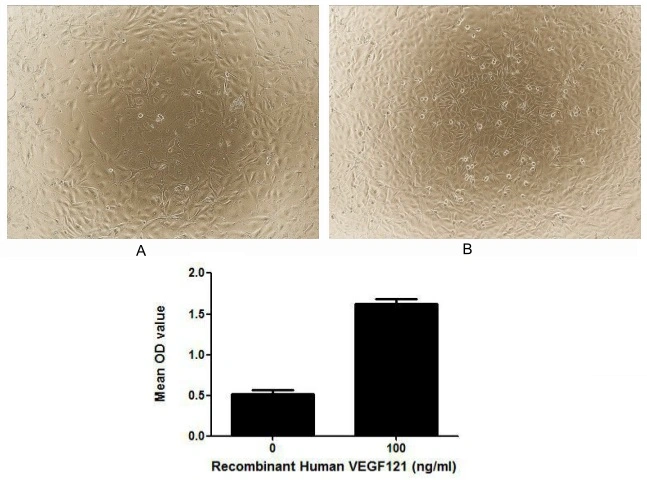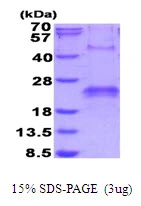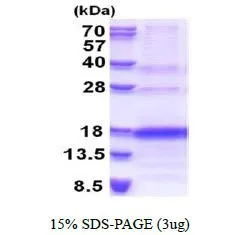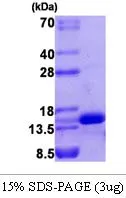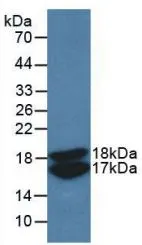
WB analysis of GTX00136-pro Human VEGF121 protein (active).
Human VEGF121 protein, His tag (active)
GTX00136-PRO
ApplicationsFunctional Assay
Product group Proteins / Signaling Molecules
Protein IDP15692
Overview
- SupplierGeneTex
- Product NameHuman VEGF121 protein, His tag (active)
- Delivery Days Customer9
- Application Supplier NoteVEGFA (Vascular endothelial growth factor A) is a growth factor and can be cleaved into several isoforms, including VEGF121. It induces endothelial cell proliferation, promotes cell migration, inhibits apoptosis and induces permeabilization of blood vessels. It is accepted that the VEGF121 isoform stimulates the proliferation of vein endothelial cells. Thus, proliferation assay of recombinant human VEGF121 was conducted using ECV-304 cells. Briefly, ECV-304 cells were seeded into triplicate wells of 96-well plates at a density of 2000 cells/well and allowed to attach overnight, then the medium was replaced with serum-free standard RPMI-1640 prior to the addition of various concentrations of VEGF121. After incubated for 48h, cells were observed by inverted microscope and cell proliferation was measured by Cell Counting Kit-8 (CCK-8). Briefly, 10 microl of CCK-8 solution was added to each well of the plate, then the absorbance at 450nm was measured using a microplate reader after incubating the plate for 1-4 hours at 37C. Proliferation of ECV-304 cells after incubation with VEGF121 for 48h observed by inverted microscope. Cell viability was assessed by CCK-8 (Cell Counting Kit-8 ) assay after incubation with human recombinant VEGF121 for 48h. And VEGF121 significantly increased cell viability of ECV-304 cells.
- ApplicationsFunctional Assay
- CertificationResearch Use Only
- ConjugateUnconjugated
- Protein IDP15692
- Protein NameVascular endothelial growth factor A, long form
- Scientific DescriptionThis gene is a member of the PDGF/VEGF growth factor family. It encodes a heparin-binding protein, which exists as a disulfide-linked homodimer. This growth factor induces proliferation and migration of vascular endothelial cells, and is essential for both physiological and pathological angiogenesis. Disruption of this gene in mice resulted in abnormal embryonic blood vessel formation. This gene is upregulated in many known tumors and its expression is correlated with tumor stage and progression. Elevated levels of this protein are found in patients with POEMS syndrome, also known as Crow-Fukase syndrome. Allelic variants of this gene have been associated with microvascular complications of diabetes 1 (MVCD1) and atherosclerosis. Alternatively spliced transcript variants encoding different isoforms have been described. There is also evidence for alternative translation initiation from upstream non-AUG (CUG) codons resulting in additional isoforms. A recent study showed that a C-terminally extended isoform is produced by use of an alternative in-frame translation termination codon via a stop codon readthrough mechanism, and that this isoform is antiangiogenic. Expression of some isoforms derived from the AUG start codon is regulated by a small upstream open reading frame, which is located within an internal ribosome entry site. [provided by RefSeq, Nov 2015]
- Storage Instruction-20°C or -80°C,2°C to 8°C
- UNSPSC12352202


